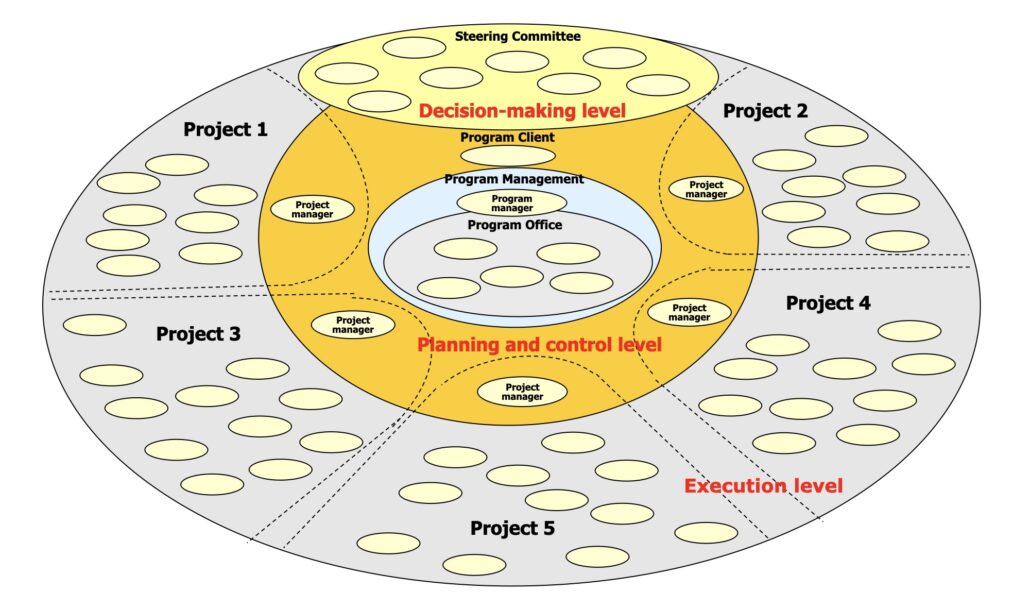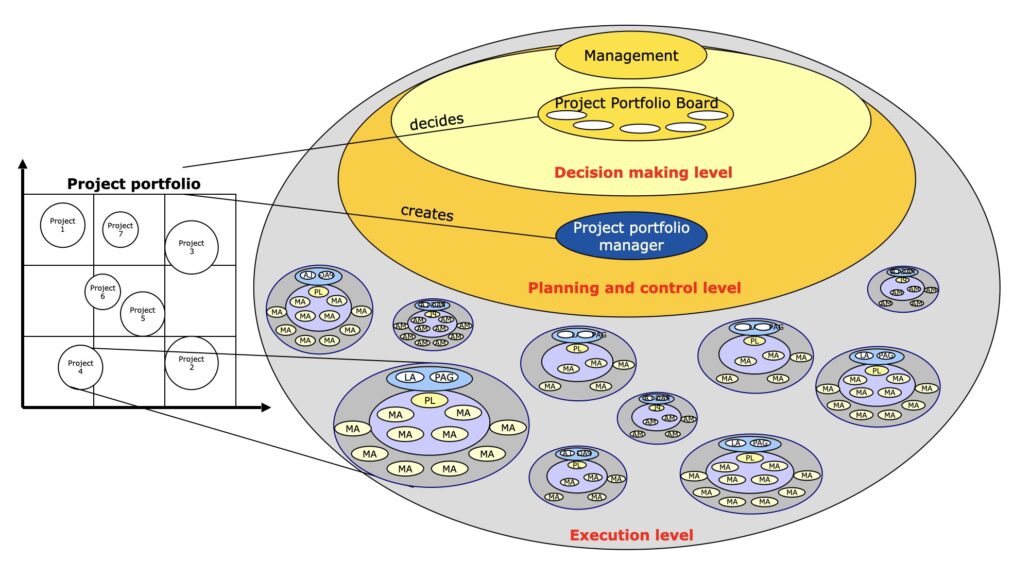This article clarifies the terms „program management“ and „project portfolio management“ to provide a clearer distinction and better understanding.
In project work, unclear or differently used terms very often lead to irritation among the people involved. In project management, two terms repeatedly cause controversial discussions, namely „program management“ and „project portfolio management„. Even technical experts discuss the definition of the two terms very diametrically. And admittedly – the similarities and differences are not obvious at first glance.
Inhaltsverzeichnis
What is Program Management?
In order to examine the term program in more detail, a comparison with a project is an obvious choice. Projects and programs have many similarities, but there are significant differences. In the joint consideration we want to examine the distinguishing features more closely in order to better understand the two terms.
Temporary management task
Like projects, programs are temporary management tasks and are handled similar to the project management process. The applied project management methodology is the same in the planning and implementation phase in the project as in the program and also the most important roles such as client, project or program manager, steering committee, etc. are largely identical.
Corporate strategy component
The most important distinguishing feature between a project and a program is the strategic orientation.
A program is a strategic task within the company that promotes an important corporate goal. In addition, programs usually initiate a „change“ in the company, which must also be designed and accompanied by the program accordingly. A component that is less important in most projects. And finally, the size, scope, duration and complexity of programs are much greater than those of projects.
Linking and joint control of projects
In order to fulfill the strategic tasks, the necessary projects are combined in one program, which are closely linked by common goals. The central coordination and control of all projects in a program is carried out by clear guidelines from the program level by the program manager, to which all projects are oriented and aligned.
The central tasks of the program manager are program planning, strategic control and management of the change process. Together with its project leaders, the Program Manager is responsible for the successful execution of the program. If a project in the program threatens to fail, the entire program success is at risk.
Example of a program organization

The linking of the projects to a program is done by Common goals and strategies
- Joint networked planning (master plan and milestones)
- Common organizational rules
- Uniform project management methods
- Communication structures and culture
- Joint program budget
- Joint program marketing
What is Project Portfolio Management?
Compared to program management, project portfolio management has become a common term in the entire management theory. The reasons for this are obvious, as the number of projects and their interdependencies in the project landscape of companies have increased significantly in recent years. It remains to be seen whether this strong growth trend will continue, but it is unlikely that the number of projects, and especially their complexity, will decrease.
Planning and control of individual projects
If we focus on the individual project first, all projects must be realistically planned and continuously controlled. The responsibility for these tasks is the responsibility of the project manager, the project client and the members of the steering committee of the respective project.
In practice, project management means fighting with scarce resources and dealing with pressure. All projects require qualified employees who must be available in sufficient numbers. Every single project is anxious to be completed quickly. Project managers and clients pursue the goals of their project, everyone tries to get the best employees and an optimal budget for „his“ project. The motto very often is: close your eyes and go through.
Permanent need for coordination of the entire project landscape
However, when several important projects are carried out simultaneously, it quickly becomes clear that neither the organization nor the company’s managers are sufficiently prepared for the overall management of projects. Due to the high number and increasing complexity of the projects, there is a permanent need for coordination.
Balancing the available resources
The content dependencies between the projects must be recognized and controlled accordingly. The allocation of available resources to the individual projects must be balanced so that an overall optimization for the company can be achieved. And finally, the company needs a regulated procedure to be able to cope with the sometimes extremely difficult project tasks.
Overall project coordination and control
For the central coordination and control of the existing multitude of projects, project-oriented companies need a well-established project portfolio management system that is integrated into the company organization and has the correctly defined goals and tasks, the right responsibilities and the appropriate competencies.
Goal of the project portfolio management
The goal of project portfolio management is the central coordination and strategic control of those projects that maximally promote the company’s goals and thus deliver the greatest benefit to the company. This makes it transparent to the company management that not all projects are equally important and that appropriate prioritization must be made.
The assignment of a company’s existing resources is focused on the „important and right projects“. In this respect, resource management is often the focus of attention.
Example: Project Portfolio Management Organization
 Central strategic control
Central strategic control
Once a company’s most important projects have been identified and prioritized, full attention is given to the strategic management of the project portfolio. The goal here is to optimize the results of the entire project portfolio and not primarily the results of the individual projects.
The project portfolio manager regularly surveys the progress of individual projects on the basis of status reports and analyzes the resulting effects on the project landscape. This requires the transparent presentation of the dependencies between the projects in order to identify existing conflict potential in time.
Project portfolio management as an ongoing process
The management of this constant dynamic in the project portfolio is a central task in project portfolio management. The project portfolio manager prepares the necessary basis for decision-making and presents it to the company management or the project portfolio board. This process is not a one-time activity but an ongoing process over the entire business cycle.
Project portfolio management has no expiration date like a project or program. On the contrary, it is a permanent institution that must be designed and controlled by the project portfolio manager.
The portfolio manager is the most important hub and service point for all project portfolio management functionaries. On the strategic decision-making level, these are the company management and the members of the project portfolio board, and on the operational level, the project managers, clients and line managers.
Program and project portfolio management – do you know the difference?
The differences between program and project portfolio management in tabular form
| Project Portfolio Management | Program Management |
|
|
|
|
|
|
|
|
|
|
|
|
|
|
|
|
|
|
